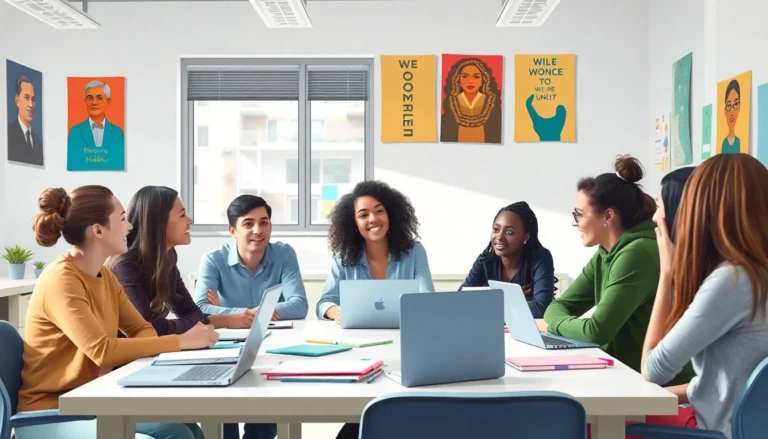In a world buzzing with opinions and ideas, dialogues and discussions are the lifeblood of communication. They’re not just about exchanging words; they’re about sparking connections, igniting creativity, and sometimes, even unraveling the mysteries of the universe—one awkward pause at a time. Whether it’s a casual chat over coffee or a heated debate in a boardroom, the art of conversation can make or break relationships.
Imagine this: you’re at a party, and someone brings up pineapple on pizza. Suddenly, it’s not just food; it’s a full-blown discussion that could lead to lifelong friendships or fierce rivalries. Mastering the nuances of dialogue can turn mundane exchanges into memorable moments. So, buckle up as we dive into the delightful world of dialogues and discussions, where every word counts and every laugh matters.
Table of Contents
ToggleOverview of Dialogues and Discussions
Dialogues and discussions serve as vital components of effective communication. They allow individuals to express thoughts and feelings while fostering understanding and collaboration. Engagement in meaningful conversations encourages the exchange of diverse perspectives, which can lead to enhanced creativity and problem-solving abilities.
Interactions can vary greatly in tone and purpose. Casual conversations may focus on personal anecdotes or opinions, while formal discussions often involve structured arguments and evidence. Both formats offer opportunities for participants to refine their viewpoints and develop critical thinking skills.
Moreover, conversations can influence both personal and professional relationships. Engaging in open dialogue cultivates trust and rapport among individuals. Effective discussions can also create memorable experiences that resonate beyond the immediate context, enriching one’s social fabric.
Providing a platform for conflict resolution, dialogues often help navigate disagreements. Adopted methods such as active listening and empathy facilitate a deeper understanding of differing positions. Acknowledging others’ viewpoints leads to mutual respect, even amidst disagreements.
Awareness of body language and nonverbal cues enhances the depth of conversation. Subtle signals can convey interest and engagement, reinforcing the spoken words. Skillful speakers often balance verbal and nonverbal communication to create a more impactful exchange.
Ultimately, the ability to engage in healthy dialogues and discussions significantly contributes to personal growth and interpersonal relationships. It requires practice and a willingness to listen and adapt. By honing these communication skills, individuals can transform ordinary interactions into powerful connections.
Importance of Effective Dialogues

Effective dialogues shape relationships and foster a deeper understanding. Engaging in meaningful conversations creates stronger bonds among individuals.
Building Relationships
Building relationships hinges on open communication. When individuals share thoughts and feelings, trust develops. Sharing personal stories during dialogues establishes common ground. Authentic conversations lead to mutual respect and appreciation. Collaborative discussions enable participants to work toward common goals. Individuals feel valued when they express their ideas freely. Respectful exchanges nurture emotional connections and strengthen interactions.
Enhancing Understanding
Enhancing understanding relies on genuine discourse. Active listening plays a critical role in this process. Participants gain insights into diverse perspectives through thoughtful dialogue. Clarifying questions deepen comprehension and promote clarity. Offering feedback enables individuals to express their views more clearly. This dynamic fosters an environment conducive to growth and learning. Exploring differing viewpoints cultivates empathy and broadens horizons. Effective communication ultimately leads to enriched relationships and improved collaboration.
Key Elements of Successful Discussions
Successful discussions rely on several key elements that facilitate meaningful exchanges. Engaging in active listening and asking open-ended questions fosters a more impactful dialogue.
Active Listening
Active listening stands out as a crucial element in discussions. It involves fully concentrating on the speaker rather than merely hearing words. Participants demonstrate understanding through verbal acknowledgments and nonverbal cues, such as nodding. This approach clarifies messages and deepens connections. Nonverbal feedback encourages speakers to share more details. Attentiveness also helps participants catch underlying emotions and perspectives. The outcome is an enriched dialogue, enabling individuals to address topics with greater depth.
Open-Ended Questions
Open-ended questions promote richer discussions by encouraging elaboration. Such questions invite participants to express their thoughts in detail. Instead of offering simple yes or no responses, they provide context and insight. These questions stimulate critical thinking, fostering a more dynamic exchange of ideas. Each participant has the opportunity to explore various angles of a topic, creating a collaborative atmosphere. The result is a more engaging conversation that encourages diverse viewpoints and strengthens connections among individuals.
Types of Dialogues and Discussions
Dialogues and discussions come in various formats, each serving distinct purposes. Understanding these types enhances effective communication skills.
Formal vs. Informal Dialogues
Formal dialogues occur in structured settings, like business meetings or academic conferences. Participants present organized arguments backed by evidence, aiming to inform or persuade. Expectations in these contexts often include a clear agenda and time constraints. Informal dialogues, on the other hand, happen in casual settings, such as social gatherings or coffee shops. Engaging in light chatter or personal storytelling cultivates connections. Both forms hold value, as formal dialogues refine critical thinking while informal ones encourage creativity and spontaneous idea exchange.
Online Discussions
Online discussions expand the realm of communication, enabling participants from various locations to connect instantly. Platforms like forums, social media, and video calls bring diverse voices into debates, fostering a rich exchange of ideas. Engaging in these discussions often requires adaptability to different communication styles. Asynchronous interactions allow individuals to share thoughts at their convenience, stimulating reflective responses. Positive engagement relies on active participation and respect for differing viewpoints. Online discussions not only accumulate knowledge but also build community through shared experiences and collaborative exploration.
Techniques for Improving Dialogues
Active listening serves as a foundation for meaningful conversations. Participants should focus fully on the speaker, avoiding distractions that may disrupt the exchange. Practicing empathy enhances understanding, allowing individuals to appreciate differing viewpoints. Clarifying questions play a vital role, ensuring that intentions and ideas are communicated effectively.
Using open-ended questions encourages deeper discussions. These questions invite responses that foster exploration of feelings and beliefs, contributing to richer dialogues. Body language must be considered, as nonverbal cues communicate feelings often more powerfully than words.
Participants benefit from reframing statements to promote positivity. Instead of critiquing an idea, they can express their perspective constructively, encouraging a collaborative atmosphere. Moreover, summarizing key points confirms mutual understanding and reinforces essential themes.
Creating a safe environment remains crucial for effective dialogue. When individuals feel respected and valued, they’re more likely to share openly. Employing humor wisely can lighten the mood, making conversations enjoyable while still addressing serious topics.
Setting time limits on discussions helps maintain focus. By establishing a clear agenda or goal, participants can steer conversations toward productive outcomes. Lastly, being mindful of varying communication styles enhances adaptability, as understanding preferences among individuals leads to more effective interactions.
Employing these techniques consistently can transform ordinary exchanges into impactful dialogues, enriching personal and professional relationships.
Challenges in Dialogues and Discussions
Dialogues and discussions present various challenges that can hinder effective communication.
Miscommunication
Miscommunication often arises from unclear language and assumptions. Participants may interpret messages differently, leading to confusion. For example, someone might use jargon unfamiliar to others, causing misunderstandings. Nonverbal cues also play a role; a misunderstanding of body language can alter the intended message. Active listening helps mitigate these issues, as it encourages clarification and engagement. Moreover, asking questions can reduce the chances of misinterpretation, making conversations more productive. Establishing a common vocabulary creates a foundation for clear exchanges, enabling participants to articulate their thoughts effectively.
Cultural Differences
Cultural differences significantly impact dialogues and discussions. Variations in communication styles exist around the world, influencing how individuals express opinions. For instance, direct communication is valued in some cultures, while others may prioritize indirect approaches to avoid confrontation. These differences can lead to misinterpretation or discomfort during discussions. Understanding cultural backgrounds fosters mutual respect and improves interactions. Educating oneself about other cultures promotes sensitivity and awareness, enhancing dialogue quality. Employing inclusive language encourages participation from diverse groups, making conversations richer and more enjoyable. Recognizing and embracing these cultural differences ultimately strengthens interpersonal connections.
Dialogues and discussions play a crucial role in shaping relationships and enhancing communication. By embracing the art of conversation individuals can create meaningful connections that foster creativity and understanding.
Active listening and open-ended questions serve as powerful tools in transforming interactions into enriching experiences. These techniques not only encourage diverse perspectives but also promote mutual respect and collaboration.
As individuals practice these skills they pave the way for personal growth and stronger interpersonal bonds. Whether in casual chats or formal settings the impact of effective dialogue is undeniable.





